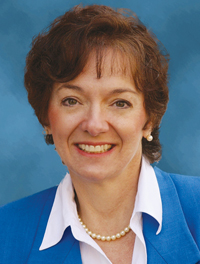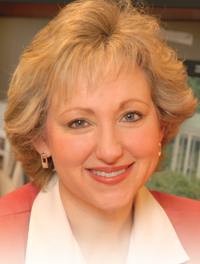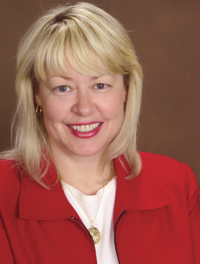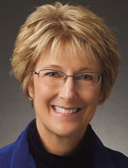 With more than 23 years of experience as a dental hygiene educator, Nancy W. Burkhart, EdD, MEd, BSDH, AFAAOM is currently an adjunct professor at Texas A&M College of Dentistry in Dallas. After earning a master’s and doctoral degree from North Carolina State University in Raleigh, she completed a 1-year post-doctoral fellowship in the section of oral pathology at the University of North Carolina-Chapel Hill Adams School of Dentistry. The faculty co-host of the International Oral Lichen Planus Support Group, Burkhart founded the organization in 1997 through Texas A&M College of Dentistry. A prolific writer, she is co-author of General and Oral Pathology for the Dental Hygienist for which she has written 30 chapters for the textbook’s three editions. A past representative on the Joint commission on National Dental Examinations for Dental Hygiene from 2014 to 2018, Burkhart is now a member of the Tri-County Human Trafficking Task Force-Dental Outreach for the Tri-County’s Healthcare Subcommittee in Charleston, South Carolina.
With more than 23 years of experience as a dental hygiene educator, Nancy W. Burkhart, EdD, MEd, BSDH, AFAAOM is currently an adjunct professor at Texas A&M College of Dentistry in Dallas. After earning a master’s and doctoral degree from North Carolina State University in Raleigh, she completed a 1-year post-doctoral fellowship in the section of oral pathology at the University of North Carolina-Chapel Hill Adams School of Dentistry. The faculty co-host of the International Oral Lichen Planus Support Group, Burkhart founded the organization in 1997 through Texas A&M College of Dentistry. A prolific writer, she is co-author of General and Oral Pathology for the Dental Hygienist for which she has written 30 chapters for the textbook’s three editions. A past representative on the Joint commission on National Dental Examinations for Dental Hygiene from 2014 to 2018, Burkhart is now a member of the Tri-County Human Trafficking Task Force-Dental Outreach for the Tri-County’s Healthcare Subcommittee in Charleston, South Carolina.
Q How did you become involved in efforts to eliminate human trafficking, and how can dental hygienists play a role?
A In 2020, I relocated my home base to Charleston, South Carolina. The COVID-19 pandemic had just begun, and the quarantine allowed me a lot of time to regroup. One bonus was the added time to do more reading. I got a copy of James Patterson’s book Filthy Rich, which outlines the life of Jeffrey Epstein and his involvement in human trafficking. As I read, I became amazed at how the human trafficking went on for many years with a host of individuals knowing full well how terribly wrong it was, and how young girls were being used, abused, and hurt. The traffickers were even obtaining them from a local high school. As I read other literature on the subject, many healthcare providers were actually treating these victims in emergency departments and clinics without even realizing they were trafficking victims. Sex or labor trafficking involves perpetrators from all realms of society and regions of the world. I began thinking that with my pathology background, oral, head, and neck signs were really not being identified in dental offices. If physicians and nurses in emergency departments were often missing the signs, the same was probably true for those of us in dentistry. So I contacted South Carolina’s State Attorney General’s Office, which put me in touch with a local organization that wanted to work with me to help obtain dental care for human trafficking victims. At this point, I have two national continuing education (CE) courses on the subject and I work with the Low Country Human Trafficking Task Force. I would like to see information about human trafficking become part of every dental curriculum and I want to provide CE on the subject, adding “dental indicators” to the discussion. South Carolina continues to make human trafficking a priority. There are legal issues and dental offices must be “trauma informed” in their approach, which requires special training. Child abuse must be reported by healthcare providers; however, the victims span many age groups, are male and female, and are both American and from other countries with a language barrier. The website of the National Human Trafficking Resource Center and Polaris—polarisproject.org—provides information on anti-human trafficking efforts. The oral, behavioral, and physical signs should not be ignored. This is a global issue that must be solved on a local level.
Q What inspired your passion for oral pathology? Please share about your work with the American Academy of Oral Medicine.
A My master’s degree is in adult education/interdisciplinary so I took quite a few courses with many other healthcare professionals such as nurses, pharmacists, and health educators. When I began my doctoral work, I was a faculty member at the University of North Carolina (UNC) at Chapel Hill, and I had the opportunity to spend a year in the Department of Oral Pathology. I always had an interest in oral pathology even in my undergraduate work. The two oral pathologists there at the time were John Jacoway, DDS, and E.J. Burkes, DDS, MS. Both were great educators who focused on the “why” a lesion occurred. I learned so much during this time and decided to write my dissertation on oral lichen planus. It was at this point during my fellowship that I assisted in microscope work/teaching; taking the graduate pathology courses, including forensic dentistry; preparing tissue samples; and observing the biopsy read-outs daily. After the 1-year fellowship, I was hired for an additional year in the pathology department. I left UNC, after the 2 years to become a faculty member at Baylor College of Dentistry with a joint appointment in the periodontics department/stomatology clinic and the Caruth School of Dental Hygiene in Dallas. In 1997, Terry Rees, DDS, MSD, and I began the International Oral Lichen Planus Support Group that I manage today after more than 20 years as an “outreach” function.
In 1997, I joined the American Academy of Oral Medicine (AAOM). Currently, I chair its Academic Affiliate Fellowship and Affiliate Membership Committee. Professionals from nursing, pharmacy, dental hygiene, dental assisting, and others involved in oral medicine are members. One feature of the AAOM is the opportunity for nondentists to become an Academic Affiliate Fellow. I obtained fellowship in 2016. I personally have made so many friends and learned so much from those involved with the organization. In 2007, Leslie DeLong, RDH, MPA, and I began to write the first edition of our General and Oral Pathology for Dental Hygienists textbook with the editors from Lippincott, Williams & Wilkins. We are currently in our third edition of the textbook and the publication is written with an oral medicine concept. I was able to draw on many of the friends/members of the AAOM and pathologists for assistance with images and advice in writing the book. I feel very fortunate to have a diverse group of colleagues.




